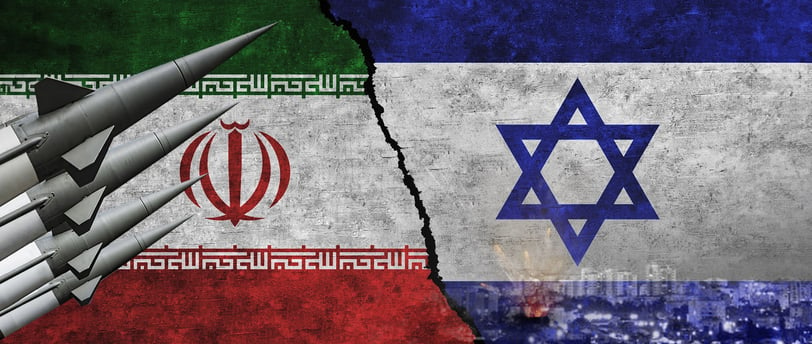Iran–Israel Escalation: Airstrikes and Missile Exchanges Rock the Region Amid Gaza War and Yemen Conflict
A detailed report on the recent Iran–Israel military escalation, including Israeli airstrikes on Iranian nuclear and military sites, Iran’s missile retaliation, and the broader regional implications amid the Gaza war and Yemen conflict.
Refaat Ibrahim
6/15/20253 min read


Tensions Begin: Israeli Assassinations of Iranian Leaders
On June 13, 2025, Israel launched a massive aerial campaign titled "Operation Morning Lion," targeting over 150 Iranian military and nuclear sites across the provinces of Bayerspour, Yasuj, Isfahan, and Tehran. Tel Aviv declared that the strikes eliminated senior leaders in the Islamic Revolutionary Guard Corps (IRGC) and nuclear engineers, claiming the operation “set back Iran’s nuclear program by years.”
Media outlets like Reuters and the Financial Times reported the existence of a small drone base established inside Iranian territory by the Israeli Mossad, aimed at sabotaging Iran’s air defense systems and delivering a precise strike against its missile infrastructure.
Israeli Prime Minister Benjamin Netanyahu stated, “What Iran has felt so far is only the beginning,” warning that operations would expand to additional sites if Tehran continued its actions against Israel.
Iran Responds with Missile Salvo: Hundreds of Missiles Strike Israel
Following the Israeli strikes, Iran launched ballistic missiles and drones toward the cities of Tel Aviv, Haifa, and Jerusalem, describing the attack as “the most powerful in decades.”
Over 150 missiles and more than 100 drones were launched in two waves directly targeting Israel, resulting in the death of three civilians from stray fire, although the majority of the attacks were intercepted.
Casualties and damages were recorded in both residential neighborhoods and military zones, with missiles striking airbases and Mossad facilities in Tel Aviv’s southern suburbs.
Tehran labeled the strikes as a “strong and decisive response,” warning that any further escalation by Israel would lead to “devastating consequences.”
Regional Spillover: Gaza and Yemen Amid Escalating Tensions
This escalation occurred alongside the ongoing war in Gaza and growing tension with the Houthi movement in Yemen, reflecting a broader anti-Israel conflict.
In Gaza, Israel continued its air and ground assaults against resistance positions, facing global criticism, even as Iran carried out its retaliation.
Meanwhile, on June 6, the Houthis launched their first missile attack on Ben Gurion Airport near Tel Aviv, signaling solidarity with Iran and Gaza.
This evolving regional dynamic shows the conflict is no longer confined to two states but has become a multi-front war involving Tehran-backed actors across the Middle East.
Economic and Diplomatic Consequences
The global economy has felt the shock: oil prices surged, while Gulf stock markets dropped by 1.5% to 3%, prompting partial shutdowns in some financial sectors.
Diplomatically, the fallout was immediate: U.S.–Iran nuclear talks were canceled, and countries such as Oman and Russia suspended scheduled coordination meetings.
Jordan and Syria declared their readiness to intercept incoming missiles, demonstrating heightened regional military alertness.
International Reactions and Escalation Risks
The United Nations issued urgent appeals to end the “escalation spiral” and avoid a wider regional war that could endanger millions of civilians.
The United States expressed full support for Israel, deploying naval and aerial forces to intercept Iranian missiles and confirming continued defense coordination.
Russia condemned Israel’s preemptive strikes as “provocative and illegal,” warning of serious implications for international security.
Key Developments and Likely Outcomes
The targeted assassination of dozens of Iranian commanders and nuclear scientists has become a central Israeli strategy.
Iran’s retaliatory strikes show its capability for large-scale offensive action if provoked.
The conflict spans several active fronts: Gaza, Yemen, Lebanon, and Syria.
The escalation is causing global economic disruption and delaying vital nuclear negotiations.
The potential for broader involvement by the U.S. and Europe continues to rise.
What Lies Ahead: Total War or Fragile De-escalation?
The region stands at a critical crossroads:
A regional war scenario could unfold with increased fighting in Yemen and Syria, potential ground escalation via Lebanon or Syria, or even direct Israeli strikes inside Iran.
Alternatively, a temporary truce could be brokered by the U.S., Russia, or China, leading to a lowering of hostilities and possible resumption of paused nuclear talks.
Awareness
Documenting reality, amplifying Palestinian voices, raising awareness.
Contact Us:
resistant.p.pens@gmail.com
Follow our social media
